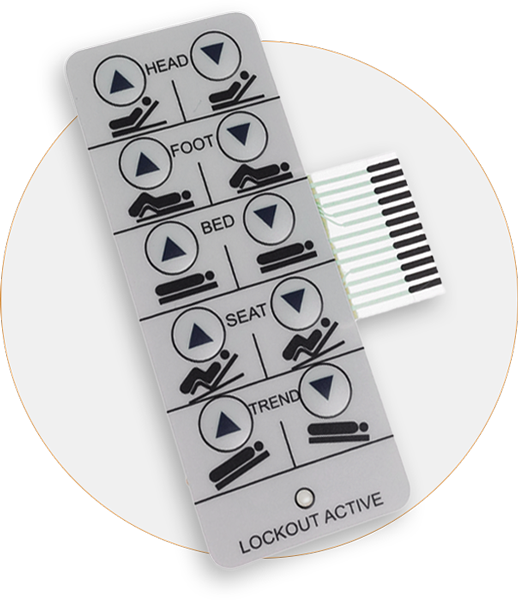Crucial Features to Try To Find When Selecting a Membrane Switch
Crucial Features to Try To Find When Selecting a Membrane Switch
Blog Article
Comprehending the Performance of Membrane Switches for User User Interface Devices
The functionality of membrane switches represents a considerable development in customer interface layout, integrating performance with visual versatility. These buttons operate with a multi-layered framework that equates user communications into electrical signals, enabling for both compact layouts and strength against ecological aspects. As industries significantly focus on individual experience, understanding the subtleties of membrane switch innovation comes to be crucial. What implications do these advancements hold for future applications, and how might they redefine individual interactions across different tools?
What Are Membrane Layer Switches?
Membrane layer buttons are cutting-edge interface tools that facilitate customer interaction with digital tools. These functional parts include several layers, consisting of a visuals overlay, spacer, and a published circuit layer. The design allows for a seamless combination into numerous electronic devices, enhancing both the visual and useful elements of interface.
Membrane layer buttons are typically utilized in a vast array of applications, from household home appliances to industrial equipment and medical devices. Their construction typically includes a thin account, making them an excellent option for small layouts. The responsive comments given by these switches can be engineered to satisfy certain customer preferences, ensuring reliable interaction in between the user and the gadget.
Sturdiness is one more significant benefit of membrane buttons, as they are resistant to dirt, moisture, and chemicals, which improves their lifespan popular atmospheres. In addition, these switches can be customized in terms of form, dimension, and visuals design, enabling branding and user-specific features. Overall, membrane switches over represent a useful service for boosting customer experience in digital gadgets, combining performance with visual appeal in a reliable manner.
Exactly How Membrane Layer Changes Job
Operating on an uncomplicated principle, membrane layer changes use a split building and construction to sign up customer input efficiently. Each switch includes several layers, including a published circuit layer, a spacer layer, and a top graphic layer, which are developed to interact seamlessly. When a user presses the leading layer, it compresses the spacer layer, bringing the conductive elements of the circuit layer right into contact with each other.
This get in touch with produces a shut circuit, indicating the tool to implement a certain function. The style enables various arrangements, including tactile responses, which can improve the customer experience by providing a physical sensation upon activation. The materials used in membrane buttons frequently include flexible substrates, such as polyester or polycarbonate, which make certain sturdiness and strength versus deterioration.

Trick Advantages of Membrane Layer Buttons

One more considerable benefit is their density. Membrane switches are slim and light-weight, which allows manufacturers to save room in their tools without giving up performance. This feature is specifically beneficial in applications where weight and quantity are essential considerations.
Furthermore, membrane switches are resistant to dirt, dampness, and chemicals, boosting their durability. This strength extends their life-span and minimizes the requirement for constant replacements, resulting in price financial savings in time.
Furthermore, the tactile responses provided by membrane layer buttons can be maximized to boost user communication. They can include functions such as raised switches or audible clicks, improving functionality see this page and individual experience.
Applications Across Industries
Interface tools using advice membrane layer buttons are common in a large selection of industries, showcasing their versatility and capability. Membrane Switch. In the medical industry, membrane layer switches are important to devices such as diagnostic tools and individual monitoring systems, where their sturdiness and ease of cleansing are critical for keeping hygiene criteria. In the automotive market, these buttons are used in dashboard controls and infomercial systems, supplying a streamlined and modern-day user interface for customers.
In addition, the customer electronics market gain from membrane buttons in devices and handheld tools, where compact design and straightforward user interfaces improve individual experience. Industrial applications additionally leverage membrane changes for control panels in equipment and automation systems, emphasizing their robustness and resistance to extreme atmospheres.
In the aerospace and protection industries, membrane layer switches are utilized in cabin controls and tools, where dependability and performance under extreme problems are extremely important. Additionally, the gaming industry significantly includes membrane layer buttons in controllers and gallery machines, contributing to an interesting user experience. Overall, the flexibility of membrane layer changes enables their widespread usage throughout countless sectors, underscoring their value in modern-day interface design.
Future Trends in Membrane Switch Innovation

Furthermore, using advanced materials, such as polycarbonate and polyester films, is expected to increase, giving enhanced toughness and resistance to ecological stressors. These materials add to the general long life of membrane layer switches, making them appropriate for harsher industrial applications.
Additionally, the consolidation of smart technology, including IoT connectivity, will certainly enable membrane layer image source switches to connect with various other devices and systems, helping with a much more interactive user experience. This trend aligns with the growing need for wise devices across numerous industries, from medical care to consumer electronic devices.
Finally, modification alternatives are prepared for to expand, permitting manufacturers to develop bespoke solutions tailored to certain individual requirements and preferences. These growths will place membrane buttons as vital components in the development of interface modern technology.
Conclusion
In final thought, membrane layer switches stand for a pivotal innovation in user interface innovation, supplying a trusted and flexible service for diverse electronic applications. As improvements in material scientific research and touch sensing modern technologies continue, the functionality and applicability of membrane switches are anticipated to increase, strengthening their importance in contemporary electronic devices.
Report this page